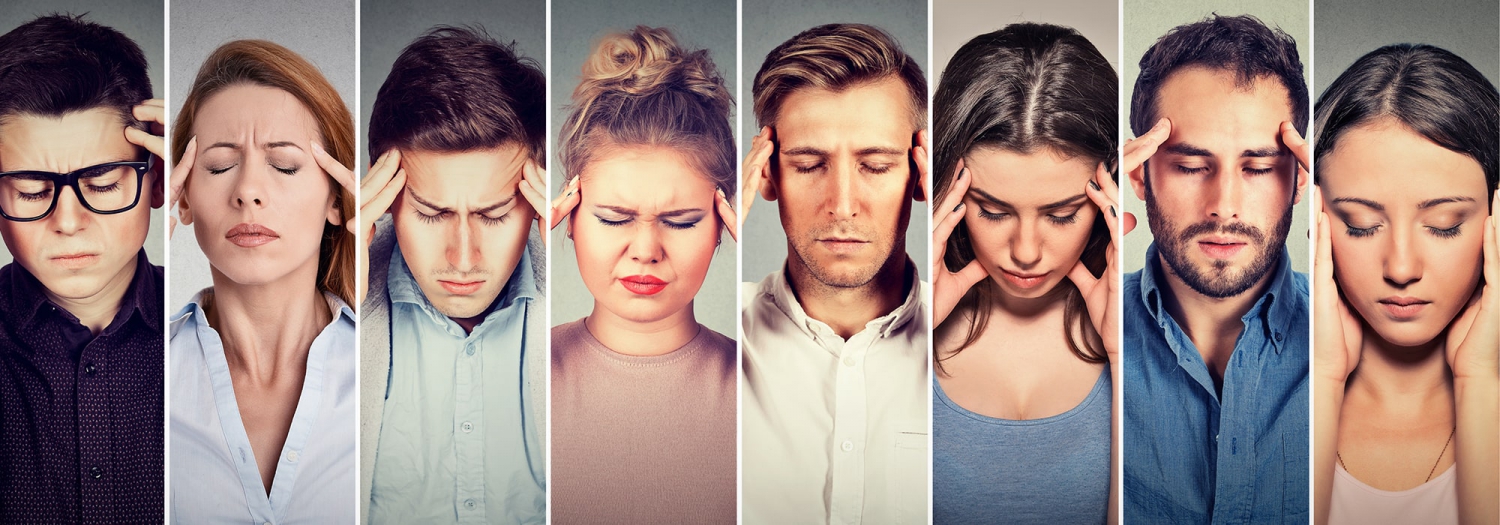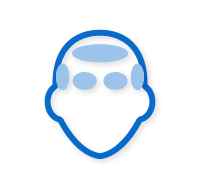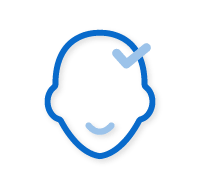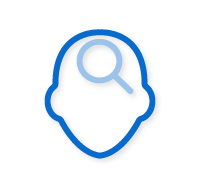Migraine definition
What is a migraine?
First of all, it’s important to specify that a migraine is no mere headache. Defining a migraine is no easy task.
In fact, there is currently no proof, no medical theory that would be able to explain migraine, to fully define it in all its complexity.
In 2000, a patient in the United States underwent forehead restoration surgery. The patient later reported that he no longer suffered from migraine. Based on this observation, a hypothesis was then put forward by specialists in peripheral nerve surgery: migraine pain could be caused by trapped nerves around the head, notably the suborbital (frontal), temporal and occipital nerves.
Nerve decompression treatments for migraine pain have since proved effective, with excellent results in relieving pain.
At our center, we invite you to fill in questionnaires to obtain good results and to find out whether or not the patient is a candidate for minimally invasive surgery to relieve the pain associated with your migraines. In some cases, an initial discussion can be held via teleconsultation. Depending on your answers to specific infiltration tests, you may be eligible for minimally invasive nerve decompression surgery to relieve migraine pain. This allows us to target the “right candidate” – those patients who can achieve definitive pain relief with minimally invasive surgery, and those who can identify one or more points in the head where the pain “starts”.
For example, you’re a good “candidate” if you can distinguish the point at which pain starts before it spreads to several areas of the head.
What can cause a migraine?
Researchers have not identified a definitive cause for migraines. However, they have found certain contributing factors that can trigger the condition or make it worse. On the one hand, the pain may be caused by a pinched nerve around the head, but on the other hand, there are factors that can exacerbate a migraine. All these factors can increase the intensity, frequency or duration of migraine pain.
These factors can include
- Bright lights
- Intense heat or other extreme weather conditions
- Dehydration
- Changes in barometric pressure
- Hormonal changes in women, such as estrogen and progesterone fluctuations during menstruation, pregnancy or menopause.
- Excessive stress
- Loud sounds
- Intense physical activity
- Skipping meals
- Changes in sleeping habits
- Use of specific medications, such as oral contraceptives or nitroglycerin
- Unusual smells
- Specific foods
- Smoking
- Alcohol consumption
- Travelling with deprivation of rest and sleep
- Stress
- High-sugar diet
- Excessive exposure to artificial light
- Working in front of a screen
- Posture problems
What kind of pain do you experience when you have a migraine?
To target the “right candidate”, we identify pains that can be relieved by minimally invasive surgery, and those that can identify one or more points on the head where the pain “starts”.
For example, you’re a good “candidate” if you can identify the point at which the pain starts when the crisis begins.
To help you see more clearly, we divide the pain associated with your migraines into three zones:
Frontal (or supraorbital) pain:
- Pain above the eyebrows (in the forehead)
- Pain in the inner eye
- Difficulty expressing yourself
- Pain usually appears in the afternoon
- Pain in the corrugator muscle of the eyebrows
- Sagging eyelid (unilateral) associated with headaches
- The patient can point to a specific spot along the orbital rim (eyebrow) where the pain begins
Temporal pain:
- Pain at the temples
- Pulsating pain along the temporal artery
- Pain in jaw and temple muscles
- Pain usually appears in the morning
- Tooth wear indicating grinding
- “Imploding” type of headache
- The patient can point to a specific spot on the temple (or temples) that strikes with the heartbeat
Occipital pain:
- Tension in the occipital nerve
- No specific time to feel pain
- Pain associated with “whiplash” or trauma to your neck
- Back muscle pain
- Pain behind or through the eye
- Basic pain: with peaks of pain.
- The patient may indicate a precise point in the nape of the neck, in the little hollow at the base of the head behind the ears, where the pain starts.
You may have all these pains, or just some, but the important thing is to be able to identify the point at which the pain starts.
Migraine sufferers describe migraine pain as:
- Throbbing
- A heartbeat in their head
- Pounding
- Debilitating
Your pain can also be dull and constant. The pain may start as mild, but without treatment it will become moderate to severe.
Most migraines last about 4 hours. If left untreated or unresponsive to treatment, they can last as long as 72 hours to a week.
In addition, more than half of migraine sufferers experience nausea as an additional symptom.
How do you diagnose a migraine that can be relieved?
At our Global Medical Institute center, we perform specific tests to understand whether minimally invasive nerve decompression surgery can relieve the pain associated with your migraines.
In the case of frontal pain or frontal migraine, we can diagnose whether your migraine pain can be relieved mainly by botulinum toxin infiltration or local anesthesia.
In the case of temporal pain or temporal migraine, we can diagnose the pain associated with your migraine, which can be relieved by local anesthetic and botulinum toxin infiltration.
In the case of occipital pain or occipital migraine, we can diagnose the pain associated with your migraine, which can be relieved by local anesthetic and/or cortisone and botulinum toxin infiltration.
The starting point of the pain is the most important piece of information. If your pain starts either at (one or both sides of) the small artery on the temples, or along the orbital rim (in the inner corner of the orbit) or in the small hollow at the base of the head behind the ears, or in a combination of these points (several of these points are possible at the same time) minimally invasive decompression surgery will probably be able to relieve the pain associated with your migraines for good.
Our doctors at Global Medical Institute diagnose your migraine by listening to your symptoms, taking a thorough medical and family history, and performing a physical examination to rule out other potential illnesses. Imaging tests, such as a CT scan or MRI, can rule out other causes, including:
- Tumors
- Abnormal brain structures
- Cerebrovascular accident
How to treat your migraine?
Migraines cannot be cured, but your doctor can help you manage migraine pain. The aim is to have as few painful attacks as possible, and to effectively treat the symptoms (the pain) when they do occur. Treatment can also help make migraine pain less severe.
The first line of treatment is to take medication to relieve attacks. However, if you cannot tolerate the side effects of migraine relief medication, or the medication is not effective enough, we can also perform minimally invasive nerve decompression, separating the nerves from adjacent structures such as muscles, vessels, tendons, etc., depending on your case. These techniques enable us to relieve your pain and help your nerves function more normally.
Your treatment plan depends on:
- Your age and how long you’ve been suffering from migraines
- How often you have migraine attacks (frequency)
- The type of migraine you have (location)
- Their severity, based on how long they last, how much pain you feel and how often they prevent you from going to school or work, or leading a normal life
- Whether they include nausea or vomiting, as well as other symptoms
- Other health problems you may have and medications you may be taking
What foods are likely to trigger migraines?
Some foods or food ingredients may be more likely to trigger migraines than others. These may include:
- Alcohol, food additives, such as nitrates (a preservative in cured meats), aspartame (an artificial sugar) or monosodium glutamate (MSG)
- Tyramine, which occurs naturally in certain foods such as herring, brewer's yeast, cheeses (cheddar, gruyère, brie), grapes, cabbage, tuna, chocolate and tomatoes.
- Caffeinated beverages can either trigger migraines or relieve some of the pain associated with them.
- A diet rich in sugar and carbohydrates (carbohydrates or starches) increases chronic inflammation, whereas a low-sugar diet is more anti-inflammatory and has proven beneficial effects on migraines.
Medical treatment, minimally invasive surgical treatment... Discover the treatments we offer at our Global Medical Institute clinic. We don't cut or burn the nerve, we decompress it, freeing it from the structures that “jam” it.
Avenue Jomini 8
1004 Lausanne
Suisse
+41 (0)21 653 29 21
Mon9h-12h 14h-18h
Tue9h-12h 14h-18h
Wed9h-12h 14h-18h
Thu9h-12h 14h-18h
Fri9h-12h 14h-18h















